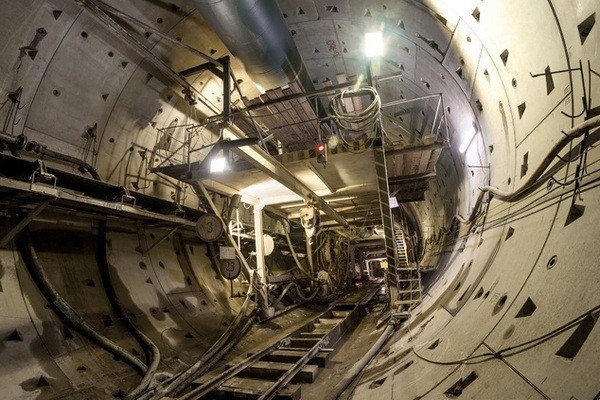
Uzbekistan Achieves Railroad Independence
Publication: Eurasia Daily Monitor Volume: 13 Issue: 41
By:

Twenty-five years after gaining its political independence, Uzbekistan has become “railway independent,” with its residents now able to travel between one part of their Central Asian republic to another, by rail, without crossing into another country—in this case, Tajikistan. On April 15, a new 123.1-kilometer line, including a 19.1-kilometer tunnel, will open, connecting the country’s capital of Tashkent with Namagan in the east (Periskop.livejournal.com, February 26).
For many, this may seem like a small story; but it is emblematic of something that almost all the countries of the post-Soviet space have had to deal with. Moreover, Uzbekistan’s transit developments are certain to have enormous consequences for several Central Asian states, given the concentration of populations from several countries living in the trans-border Ferghana Valley area. And while this trend will further separate these neighboring republics, it may, in fact, reduce tensions by allowing each of them to have better control over their own territories. Moreover, it may allow them to negotiate with their neighbors on the basis of equality rather than being hamstrung by the inter-dependence problems that were associated with the earlier transportation arrangements.
In Soviet times, Moscow drew political borders according to a very deliberate set of principles—both to recognize the dominant ethnic group in particular territories and to engage in divide-and-rule policies. However, Moscow typically ignored these political borders when it came to building transportation infrastructure like highways and rail lines and had them pass along the most geographically and economically convenient paths, even if that meant the residents of one republic would have to pass through another in order to go from one part of their homeland to another. From the perspective of the Soviet authorities, such arrangements promoted the integration of the country, although far from all residents agreed or liked that outcome.
Last year, this survival of the past attracted some international attention when the Russian government announced that it planned to build a short rail spur to allow Russian trains to go from Moscow to the south of the country without passing through Ukraine (see EDM, October 5, 2015). And earlier, in an analogous development, Baltic plans to shift from the Russian-gauge to international-standard-gauge track also gained some attention (Windowoneurasia2.blogspot.com, July 25, 2013; Railway Gazette, July 24, 2013). These projects are essential to the unpacking of the Soviet inheritance; but like the case in Uzbekistan, they are expensive. Many have argued against them not only because of their cost, but because they fly in the face of efforts at regional integration and cooperation.
Nevertheless, Uzbekistani officials are celebrating the fact that their country has “finally achieved complete connectivity of its territory by rail and escaped from the Soviet configuration, which did not pay attention to the borders of union republics but went along the most topographically optimal path.” Prior to the end of the Soviet Union, this did not always matter much—no one had to clear a border crossing or show a passport—but since 1991, it has been a continuing source of irritation and tension.
In the case of Uzbekistan, local residents say, “Uzbek trains in the Ferghana Valley were forced to pass through the territory of hostile Tajikistan.” For much of the period, there did not seem to be any alternative, given that a direct route would require a 19.1-kilometer tunnel. Expensive and difficult to build, such a tunnel would be the longest one in the former Soviet space, nearly four kilometers longer than the Severomuysky Tunnel, in southeastern Russia.
But national pride and continuing tensions with Tajikistan drove Uzbekistan to build the underground railway corridor. The project began two years ago. Construction is now completed, and the entire line is scheduled to open on April 15 (Anhor.uz, February 25).
The opening of this tunnel will have, at a minimum, three consequences:
- First, it will dramatically increase Tashkent’s ability to control the eastern portion of the country in the oft-troubled Ferghana Valley, allowing the Uzbekistani government to shift troops from one place to another without having to worry about delays at the border with Tajikistan. Indeed, this is likely the primary reason that Uzbekistan’s authorities decided to embark on this project.
- Second, it will reduce tensions between Uzbeks and Tajiks by eliminating what has been a sore point in relations. Many Uzbekistanis have been outraged that they could travel from one part of their country to another only by going through another Central Asian republic. Now this will no longer be necessary. And with this source of tension behind them, it may allow Tashkent and Dushanbe to expand their bilateral cooperation in other areas.
- And third, Uzbekistan’s achievement will likely put more pressure on other governments to take steps, when possible, to ensure that all parts of their country are connected via links on their own territories. Sometimes that is not possible, as for example when Azerbaijanis have to travel via Iran to reach the exclave of Nakhchivan or when Tajikistanis, Kyrgyzstanis and Uzbekistanis must pass through the territory of a foreign state to reach one of Central Asia’s many small exclaves (see EDM, May 28, 2013).
Finally, it bears pointing out that China supported Uzbekistan’s railway development project and would likely support others. Indeed, China more likely than not views such transit infrastructure investments as a remarkably inexpensive way to win friends in the region and promote these countries’ reorientation away from Moscow toward Beijing.




